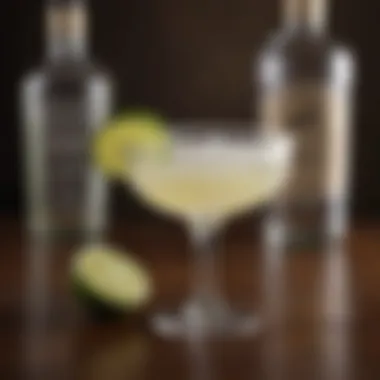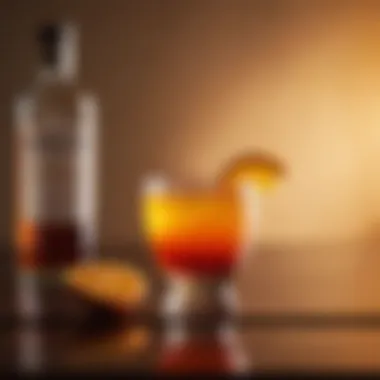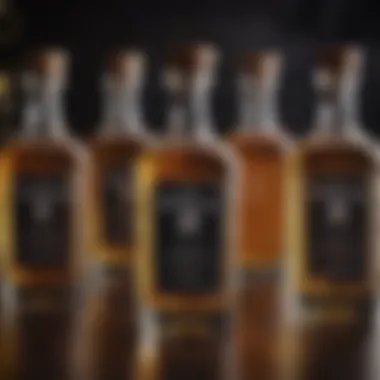Unveiling the Art of Tequila Cocktails: Recipes and Tips


Intro
Tequila cocktails are an exquisite expression of tradition and creativity. This article aims to unfold the layers of this vibrant topic, exploring recipes that illustrate the complex profiles of tequila. Tequila's roots in Mexican culture offer a rich history that adds depth to every sip. Understanding the development and crafting of tequila, combined with the diversity of cocktail applications, creates an enlightening experience for both enthusiasts and newcomers alike.
Key Points
- The History of Tequila: Dive into its origins and significance within Mexican culture.
- Production Methods: Learn how terroir and methods influence the flavors in different tequilas.
- Popular Cocktail Variations: From the classic Margarita to innovative craft cocktails, discover what garners attention in bars today.
- Best Tequila Brands: Gain insight into brands that stand out for quality and flavor.
- Tips for Creating Cocktails: Master the art of tequila mixology with expert tricks.
- Elevating the Experience: Explore how to develop a sophisticated palate for tequila.
Exploring the unique characteristics of tequila will not only enhance the drinking experience but also offer a deeper appreciation for this spirit's cultural embodiment. As we progress through this article, seekers of knowledge and flavor refinement will find ample material that meets high standards.
Understanding Tequila
Tequila is not merely a spirit; it holds an intricate past and a crafting excellence that invite exploration. An understanding of tequila is fundamental for anyone seeking to appreciate the world of tequila cocktails. This knowledge enhances one's ability to choose the right spirit for mixing while also appreciating its individual flavors, origins, and classifications. Consideration of tequila's characteristics allows a more informed selection when undertaking cocktail creation, fostering satisfaction for the drinker. In this section, several critical topics will be discussed, including the origin, types, and production process of tequila.
The Origin of Tequila
Tequila finds its roots in the town of Tequila, located in the Jalisco region of Mexico. It has been produced since the 16th century, evolving from the indigenous practice of fermenting the blue agave plant. Over centuries, tequila transitioned from a local beverage to an international icon, frequently associated with celebration. In 1974, tequila was designated as a protected designation of origin (PDO), ensuring that only spirits made from blue agave in specific regions can be labeled as tequila. This legal distinction underscores its cultural and historical significance in not just Mexico, but the wider world.
Types of Tequila
Various styles of tequila exist. Understanding these types is essential when planning cocktails, as each offers distinct flavors. The classification is primarily based on age and processing. Below are the main types of tequila:
blanco
Blanco tequila, often referred to as silver tequila, is clear and typically unaged. It is bottled right after distillation or kept for less than two months in stainless steel barrels. Its fresh flavor profile captures the vibrant essence of the blue agave plant. Blanco tequila is well-suited for cocktails like Margaritas and is favored for its clean and crisp taste. Some may argue that it lacks complexity since it avoids the aging process. However, its straightforward flavor is invaluable when seeking an agave-forward experience.
Reposado
Reposado means "rested" in Spanish. This variety is aged for a minimum of two months but less than a year in oak barrels. The aging imparts a light golden hue and enriches the tequila with woody notes. Reposado is often celebrated for balancing the agave flavors with subtle oak characteristics. It can be an excellent choice for cocktails that benefit from a touch of softness, such as a Paloma or a Reposado Margarita. The slight complexity introduced by aging can be advantageous, though the beverages may diverge from those seeking purely agave-forward notes.
Añejo
Añejo, meaning "aged", refers to tequila that has matured for a minimum of one year but less than three years. The longer aging period deepens the color and intensifies the flavor. Aged in charred oak barrels, Añejo can develop rich notes of caramel, vanilla, and spice. This type is often regarded as luxurious and is commonly enjoyed neat or in upscale cocktails. The complexity provided serves well in sophisticated mixes. However, for those who prefer an agave-forward taste, Añejo might venture too far from its roots.
Extra Añejo
This category pertains to tequila aged for over three years. Extra añejo offers an abundant flavor profile with even deeper complexities than regular añejos. The combination of oak and agave creates a symphony of flavors that can include dark chocolate, leather, and even dried fruits. This tequila is best savored neat or in carefully crafted cocktails where its richness is highlighted. The premium quality often comes at a higher price point, which may not appeal to everyone seeking quick mixes but allows for elevating special occasions considerably.
The Production Process
The creation of tequila is a meticulous process, beginning with the selection of the blue agave plant. Harvesting, or 'jimadors', uses a specialized method to extract the heart of the agave, called piña. Cooking the piñas transforms the starches into fermentable sugars. Once cooked, the agave is shredded and combined with yeast for fermentation, producing alcohol. Distillation then occurs to purify the beverage and concentrate its flavors. Finally, based on the type of tequila desired, it is aged in barrels or bottled as blanco. As we deepen our exploration, the production intricacies become especially relevant. Understanding these steps not only increases appreciation but also informs clever pairing choices for cocktails.
Essential Ingredients for Cocktails
The foundation of any excellent cocktail lies in the ingredients it uses. Understanding the essential components that contribute to a tequila cocktail is vital. These components enhance the drink's flavor profile and ensure a pleasant tasting experience. Quality ingredients play a crucial role in this as they can significantly influence the balance of flavors and the overall appeal. For aspiring mixologists and casual enthusiasts alike, this section offers guidance on selecting quality tequila, common mixers, garnishes, and presentation techniques.
Selecting Quality Tequila


When it comes to selecting tequila, the choice of quality is paramount. Quality tequila enhances the overall flavor of cocktails and differentiates a good drink from a sublime one. Higher-end brands may have a more complex flavor profile and smoother finish, making them better suited for cocktails where tequila is foremost. Recommended brands for premium tequila include Don Julio, Patron, and Espolon. Each of these brands offers various types of tequila, from Blanco to Extra Añejo. Combining brand selection with the knowledge of tequila typology can elevate a cocktail significantly.
Common Mixers
Mixers can completely transform how tequila cocktails are enjoyed. They not only add flavor but also alter the texture and appearance of the drink. It is essential to select mixers that complement the tequila rather than overwhelm it. Here are some popular choices:
- Citrus Juices
Citrus juices are central to many tequila cocktails, such as Margaritas and Paloma. They provide acidity and freshness, which help brighten tequila's more robust flavors. Freshly squeezed lime or lemon juice often imparts a much more vibrant taste compared to bottled options. Additionally, citrus juices can enhance the olfactory attributes of a cocktail, appealing to multiple senses. - Syrups
Syrups bring sweetness and texture to cocktails. They can vary from simple sugar syrup to more complex varieties like agave nectar. Agave nectar is especially beneficial as it shares flavor similarities with tequila. By adjusting the syrup's degree of sweetness, the mixologist can attain better control over the balance within the drink. However, excessive sweetness can dull the flavors found in quality tequila, which makes it essential to measure carefully. - Bitters
The use of bitters in tequila cocktails is becoming more mainstream. This ingredient adds depth, dimension, and complexity to drinks. Aromatic bitters, such as Angostura, complement tequila's notes well and offer a subtle contrast that can elevate standard cocktails to new heights. Like syrups, a little goes a long way. Excess encouragement can easily overpower the other flavors present in a drink. - Herbs and Spices
Utilizing herbs and spices can bring a new level of sophistication to tequila cocktails. Ingredients such as basil, rosemary, or even chili can introduce earthy undertones and layers of taste. Incorporating fresh herbs also can create aromatic elements that entice the drinker. However, these flavors should be used thoughtfully as overpowering herbs may clash instead of harmonizing.
Garnishes and Presentation
Garnishes serve not just an aesthetic purpose; they elevate the entire drinking experience by engaging the sense of sight and aroma. Simple enhancements like a lime wheel or a sprig of mint can significantly influence one's first impression of a cocktail. Presentation matters in creating an unforgettable experience. Choosing glassware that showcases the drink's vibrant colors and using creative garnishing techniques will serve well in distinguishing cocktails from one another. For luxury audiences, pleasing presentation gives the impression of craft and careful thought, contributing to an overall luxurious experience.
“The right garnish enhances the drink, engaging the mind as well as the palate.”
Taking the time to select high-caliber tequila, thoughtful mixers, and well-planned garnishing methods creates an artisanal cocktail experience worthy of any discerning palate.
Classic Tequila Cocktails
Classic tequila cocktails stand as fundamental representations of cocktail culture, showcasing the versatility and richness of tequila as a base spirit. Delving into these timeless drinks helps to appreciate the intricate layering of flavors, the balance between sweetness, bitterness, and acidity, and the harmonious interplay of ingredients. Understanding these classic recipes gives both the novice and the seasoned aficionado foundational knowledge essential for crafting various tequila cocktails. Each cocktail tells its own story through history and locale, reflecting cultural influences and the evolution of bartending artistry.
Tequila Sunrise
The Tequila Sunrise is a visually striking cocktail known for its gradient-like appearance, blending bright orange and red hues to evoke the beauty of a sunrise. Its simplicity makes it a popular choice among casual drinkers while offering depth through the layers of flavors provided by tequila, orange juice, and grenadine syrup. To prepare it, one typically fills a glass with ice, then combines tequila and orange juice, finishing with a slowly poured splash of grenadine. This technique allows for the classic faux ombré effect, resulting in a drink that is as attractive to the eyes as it is satisfying to the palate.
Considering the ingredients, it is important to select a tequila that balances well with the mixers. A respectable Blanco or Reposado will contribute complexity without overpowering the fresh citrus notes.
Margarita
The Margarita is perhaps the most iconic tequila cocktail, recognized worldwide for its refreshing qualities. Usually composed of tequila, triple sec, and fresh lime juice, the Margarita epitomizes the embodiment of simplicity in cocktail-making through its balance of salty, sweet, and citrus flavors. The cocktail presents versatile ways of preparation — whether served on the rocks, blended, or presented in a traditional glass with a salted rim, the Margarita remains approachable for all preferences.
Crafting a Margarita requires careful measurement of the ingredients to maintain balance. A common ratio of 2:1:1 for tequila, triple sec, and lime juice ensures that the flavors do not muddle each other. Fresh lime juice enhances the flavor incomparably, while ready-mixed options tend to lack character.
Paloma
The Paloma has gained immense popularity in recent years, acknowledged for being a refreshing alternative to more established tequila cocktails. This drink balances brightness with lightness, combining tequila with grapefruit soda or fresh grapefruit juice and lime. A traditional recipe often features a pinch of salt on the rim, allowing each sip to unlock distinguished flavor experiences.
Realizing its refreshing aspect, people might consider the Paloma an excellent option during warmer months or at outdoor gatherings.
Selecting quality tequila still applies here, with popular recommendations leaning towards Blanco varieties that shine through the fresh, fruity elements of grapefruit. Each element enhances the drinking experience while illuminating the unique character of tequila, inviting enthusiasts to appreciate the craft further.
Traditional cocktails like the Tequila Sunrise, Margarita, and Paloma offer accessibility and classic appeal. Their prep is straightforward yet allows discretion in infinitesimal details—the late adjustment of sweetness or bitterness—that fully elevate each libation into a sophisticated taste experience.
Innovative Tequila Cocktails
Innovative tequila cocktails represent a vibrant and evolving corner in the world of mixology. They challenge traditional notions, pushing the boundaries of flavor combinations while preserving the integrity of tequila. Artisans and enthusiasts continuously reimagine classics, offering fresh perspectives on this versatile spirit.
Exploring novel recipes can elevate not only a cocktail menu but also the drinking experience. Such creativity invites enthusiasts to engage with tequila in unexpected ways, encompassing new textures and flavor profiles. Unique cocktails can also express local culture and trends, integrating regional ingredients and influences into concoctions that resonate with contemporary palates.
Tequila Mule


The Tequila Mule provides a refreshing twist on the classic Moscow Mule. To craft this invigorating drink, you will need high-quality tequila, ginger beer, and fresh lime juice. The dynamism of the ginger beer blends beautifully with tequila, creating a delightful contrast. This cocktail maintains effervescence, making it particularly appealing during warmer months.
To prepare a Tequila Mule:
- Fill a copper mug or glass with ice.
- Pour in 2 ounces of tequila and the juice from half a lime.
- Top it off with ginger beer to taste.
- Stir gently and garnish with a lime wedge.
This drink highlights tequila's versatility and engages those who may have preferred vodka in a new taste experience.
Tequila Sour
Tequila Sour is an intriguing concoction that marries tequila with the classic principles of a sour cocktail. It balances the punch of tequila with sweetness and acidity, using simple ingredients like fresh lemon juice and a sweetener. Adding an egg white gives it a luxurious, frothy top, further enhancing the palate's play.
Crafting this cocktail involves:
- Shaking 2 ounces of tequila,
- Half an ounce of fresh lemon juice,
- One ounce of a simple syrup, and an egg white if desired.
- Shake vigorously without ice to emulsify the egg white, then add ice and shake again.
- Strain into a coupe glass and garnish with a twist of lemon peel or a cherry.
Tequila Old Fashioned
This reinvention of the classic Old Fashioned replaces bourbon with tequila, providing a deeper complexity. The rich flavors of añejo tequila work excellently with bitters and sugar. This cocktail appeals to whiskey drinkers looking for something new yet familiar.
To make a Tequila Old Fashioned:
- Muddle a sugar cube with two dashes of Angostura bitters in a glass.
- Add 2 ounces of añejo tequila and a large ice cube.
- Stir until chilled and diluted.
- Garnish with an orange twist or a cherry for added aromas.
Combining traditional techniques with the vibrant spirit of tequila widens the appeal of these innovative cocktails. As interest in tequila grows, discerning audiences can expect more imaginative concoctions that showcase the spirit's depth and character.
Crafting the Perfect Tequila Cocktail
Crafting the perfect tequila cocktail is an art that transcends mere mixing of spirits and ingredients. It is not only about selecting the right elements but also involves an understanding of techniques, presentation, and even the ambiance of the drinker’s experience. Tailored moderation elevates tequila cocktails from basic drinks to sophisticated creations worthy of high-end gatherings and intimate settings. The process hinges on various considerations; understanding mixing techniques is essential, as it can significantly alter the cocktail's flavor profile and texture.
Mixing Techniques
Mixing techniques fundamentally influence how tequila interacts with other components of a cocktail. Precise methods yield different textures, tastes, and aromas. There are various methods to consider:
- Shaking: This technique combines ingredients with ice, aerating the mix and enhancing flavors. It is ideal for fruit-based cocktails like the Margarita where freshness is vital.
- Stirring: Used for spirit-heavy mixes, stirring results in a more uniform composition and a smoother finish. It is appropriate for cocktails like the Tequila Old Fashioned.
- Muddling: By pressing herbs or fruits in the glass, muddling releases essential oils and garden-fresh aromas. This technique is commonly used in cocktails like Tequila Mojito.
Understanding when and how to apply these techniques can help in achieving the desired cocktail experience. The success of a tequila cocktail lies largely in balancing the elements involved, a delicate undertaking worthy of practice.
Rim Options and Their Significance
Rim variations contribute not only to appearance but also play a pivotal role in the overall taste of tequila cocktails. While añejo tequila might be consumed neat, a rimmed glass suits many cocktails. The uncertainty of rimming flavors adds a compelling edge.
Common rim options include:
- Salt: Enhances the natural flavors of tequila; ideal for cocktails such as the Margarita.
- Sugar: Adds sweetness; often dusted on drinks involving fruit juices that benefit from a light syrupy flair.
- Chili Powder: Delivers a spicy kick, enhancing cocktails that rely upon bold flavors while complementing the agave spirit's earthy notes.
It’s crucial to seize the opportunity to experiment; a creative rim can transform a standard drink into a unique artisan experience. Rimming methods affect not just the taste but also the presentation, making the cocktail’s allure more significant to discerning patrons.


Temperature and Glassware
The temperature and choice of glassware in which a tequila cocktail is served can dictate the drinking experience profoundly. Each cocktail, determined by the technique and ingredients applied, demands a different serving temperature to attain the optimal balance. General guidelines include:
- Chilled Glasses: Ideal for shaken cocktails; ensures a refreshing sip with each taste.
- Room Temperature: Best for neat and stirred cocktails, underlining the full flavor of the spirit without dilution.
Selecting the appropriate glass has both functional and aesthetic implications. Certain spirits necessitate specific designs, like traditional (and beautiful) tumblers or stemmed glasses. This enhances not only the practicality but also stars in so many networks of style and luxury, touting exquisite designs reaches even beyond that.
The Role of Tequila in Contemporary Mixology
Tequila continues to steadily carve out its position within the space of contemporary mixology. In recent years, the spirit has transcended traditional boundaries, becoming a staple not just in classic cocktails but also in innovative creations. This evolution is important for both seasoned mixologists and casual cocktail enthusiasts.
One prominent aspect of tequila's rising prominence is its versatility. Unlike spirits that have a limited range of taste profiles, tequila provides a wide spectrum of flavors based on its age and production process. This allows bartenders to be more creative and experimental with their drink menu. Whether it is smooth Blanco for refreshing cocktails or mature Añejo to enhance sophistication in a drink, tequila serves multiple purposes.
“Mixology isn't only about combining ingredients. It's about balancing textures, flavors, and above all, experiences.”
Tequila's Popularity Surge
The surge in tequila's popularity aligns with growing trends in cocktails focusing on high-quality, handcrafted ingredients. As more cocktail bars prioritize artisanal spirits, tequila fits seamlessly into the mix. Recent statistics demonstrate that tequila sales globally have risen substantially. Many people associate tequila with celebrations, but sophisticated palettes now appreciate its complexity during simple gatherings as well. Consumers are now preferring premium brands like Patron and Casamigos, leaving behind the misconceptions about mixing this spirit.
Additionally, numerous cocktail events and festivals celebrate tequila distinctly, further solidifying its place in today's drinking culture. Bartenders recognize the acute demand for tequila-based drinks and respond accordingly by adding unique offerings to their menus. Events focusing on tequila not only elevate its status but also provide a platform for education about the spirit's finer nuances. This positions tequila as an enduring favorite among discerning drinkers.
Signature Cocktails from Renowned Bartenders
Within the realm of mixology, renowned bartenders are pushing the boundaries of tequila cocktails. Their signature creations reflect the spirit's malleability while showcasing distinct flavor profiles. Programs in trendy bars emphasize cocktails that rely heavily on high-quality tequila.
A few notable cocktails that have garnered attention include:
- Tequila Old Fashioned: A sophisticated twist on the classic old fashioned, this drink uses tequila instead of whiskey, paired with simple syrup, bitters, and often a twist of citrus to enhance the flavors.
- Tequila Smash: This cocktail typically incorporates muddled herbs and fresh citrus, lending it a refreshing aura that embodies the spirit's versatility.
- Paloma: Renowned for its simplicity, this drink combines tequila with grapefruit soda, lime juice, and a salted rim, making it a staple at high-end bars.
These cocktails are a testament to the endless creativity that tequila inspires. Mixologists take cues from diverse influences to shape their drinks, aimed at surprising and delighting patrons.
As the world becomes increasingly more interested in specialized cocktail experiences, understanding the nuances of tequila and its role in enticing creations remains paramount. Luxury establishments continue to expand their cocktail lists to include tequila variants, enhancing their appeal to sophisticated patrons. This secure foothold not only influences individual enjoyment but also elevates the overall reputation of the spirit in contemporary mixology.
Tequila's Cultural Significance
Tequila is more than just a spirit; it embodies a deep-rooted heritage that spans centuries, encapsulating the very essence of Mexican culture. The creation and consumption of tequila involves an intricate relationship with land, tradition, and community. Its significance extends beyond geographical borders, influencing drinking practices and perceptions around the world.
Tequila in Mexican Traditions
In Mexico, tequila plays an essential role in various traditions and celebrations. From birthdays to weddings, it features prominently, often consumed straight, accompanied by salt and lime. Festivals such as the National Tequila Fair celebrate this iconic drink, showcasing its cultural importance.
- The production of tequila itself is steeped in centuries-old customs, with families over generations producing their own varieties using traditional methods.
- Rituals associated with tequila involve communal aspects, promoting social bonding among family and friends. A shot of tequila unifies, allowing for stories and memories to flow, mirroring the vibrant connections within Mexican communities.
Moreover, tequila spirits form part of artisanal expressions with local distilleries known as **
End
The exploration of tequila cocktails yields significant insights into a realm that transcends mere drinking. A intricately crafted cocktail can encapsulate an entire cultural experience. This article navigated through various ingredients, rich cocktails, and innovative methods essential for creating the perfect drink worthy of sophistication.
Understanding the foundations of tequila, including its origin and various classes such as Blanco and Añejo, is essential for appreciating premium cocktails.
Key Considerations for Enthusiasts:
- Quality Tequila: Beyond just micro-distilleries, brand reputation carries weight. Select from top-tier brands known for their craftsmanship.
- Mixing Techniques: Employing right techniques ensures every drink is consistent in flavor and presentation.
- Cultural Significance: Appreciating tequila’s status in Mexican culture complements the enjoyment of these cocktails. Tequila serves as a bridge between traditional Mexican values and contemporary mixology.







